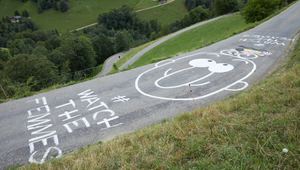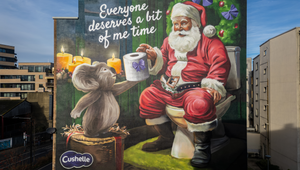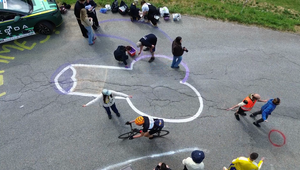
Creative Alchemy - Street Art & Sonnets

Global Street Art is on a mission: to live in painted cities. Their studios are nestled in the middle of London’s Old Street, where we took the lift down to the basement of an otherwise plain and unassuming building. The labyrinth beneath meant that you’d get lost trying to find the toilet. But it also had hidden in it workshops where individuals were creating nothing short of magic. Magic that was getting ready to be splattered over big spaces by the intricate hands of graffiti artists.
With the Banksys of the world aside, graffiti has long been an underappreciated art form around the world in artsy circles. It was GSA co-founder, Dr Lee Bofkin, who had the impressive idea to give graffiti artists a place where their work could be not only appreciated, but remunerated.
The first visit was an exploratory one, where you felt as if you were walking around the kind of museum that doesn’t exist in the real world. There’s a really vocal office dog, lovingly named Paint Brush (PJ for short). One room has its walls covered with old cartoon drawings collected from decades past, telling the story of Britain through intricate scribblings. There are shelves filled to the brim with files that have within them collections of hundreds of years of train tickets, displaying their artwork. Cigar packages. Crisp wrappers. Victorian Masks. It’s every collector's wet dream. But to Lee, it’s way more than collecting. It’s paying homage to those who paved the way for creators today. Artforms otherwise long forgotten, would not be here. Not on their watch. Here, there are people who care about what has been.
That’s where, on our second visit, we met GSA artist, Pete Barber.
We sat down surrounded by history; Pete’s wearing a chequered shirt, hat, and cheeky smile. His demeanour is disarming. He’s happy-go-lucky and easy to talk to and speaks in tangents that all round off into a point that seems well thought out, without that being the intention.
The conversation went something like this:
A little known fact is that Stratford-upon-Avon is the UK’s second most popular tourist destination; only superseded by London (of course). Every year, puddles of people flood off of buses in their tens of thousands, to walk down the streets that Shakespeare once did. All hoping they might get to touch, feel, absorb, some of that history. But here's the thing: when they get off the tour bus, they land on a pretty dilapidated highstreet. Having reached out to Shakespeare's Birthplace Trust and the Stratford-upon-Avon council, GSA ended up with the idea of reviving the space. They were given permission to create something that might ignite the richness of history that was no longer viscerally represented in that specific place.
The idea was simple: six widows, each representing a specific sonnet, denoting its own theme. The themes identified were: Love, Infidelity, Time, Mortality, Jealousy and Beauty. Pete knew it would be important to play with depth in order to tell the story, so when writing the brief for other artists, he said he wanted the empty shops to be treated like mini stage sets. “Of course the challenge would be bringing out the theme without any voices or songs. In place of actors, we would have still art” explains Pete. “But I wanted to give the artists a different kind of brief; something that would stimulate their creative freedom, in a way that was outside of the normal mode of working. I wanted them to treat it as a broader concept.”
Conceptualisation
Pete’s theme was Beauty, coming from Sonnet 130 entitled, ‘My Mistress is Nothing Like the Sun.’ Pete usually works on the commercial side of the business (which he loves). What this means, however, is that his creative flow is usually quite orchestrated. This was an opportunity to stretch.
My mistress' eyes are nothing like the sun;
Coral is far more red than her lips' red;
If snow be white, why then her breasts are dun;
If hairs be wires, black wires grow on her head.
I have seen roses damasked, red and white,
But no such roses see I in her cheeks;
And in some perfumes is there more delight
Than in the breath that from my mistress reeks.
I love to hear her speak, yet well I know
That music hath a far more pleasing sound;
I grant I never saw a goddess go;
My mistress, when she walks, treads on the ground.
And yet, by heaven, I think my love as rare
As any she belied with false compare.

The piece has long been renowned amongst literary fanatics as one of the unappreciated greats of Shakespeare's work. That’s because it went against the grain of the usual style of upholding one's lover as the best thing since sliced bread.
The Sonnet brings to the fore, imagery which could be considered gruesome at times. Some say that Shakespeare wrote this as a kind of parody, poking fun at other writers who were using overly flowery language to describe their lover. Prescribing metaphors that had no basis in reality. They were missing the point; saying the apple of their eye looked a certain way for the sake of romanticising it, leaving the actual outcome void of any real meaning at all. Shakespeare had other ideas. And subsequently, so did Pete.
Pete read the piece a few times, but admitted he found other people’s synopsis of it far more exciting. The concept instantly took shape in his mind - an occurrence he acknowledged as a rare gem, even amongst seasoned artists.
A father of four and a self-confessed ‘big romantic’, Pete loves talking about authentic love - meaning Sonnet 130 was right up his street. “Family and love is gritty. Without that, it’s just glitz and glitter and nonsense.” The grit, inherent in family life and the sonnet, would become the foundation of his idea. Pete wanted to combine beautiful and classical images of beauty and love with the gnarly, gritty, dried, distressed, aged and splintered. His daughter happens to be a florist who specialises in dried flowers, which Pete called upon to add depth and texture to his window. “Flowers are usually celebrated because they’re fresh and colourful. But that's only for a moment. But if you take the care to dry them, yes, they will use that springlike lustre, but they will still have everything else that’s beautiful about them.” These elements implied to motion he had been hoping to achieve.

Pick a Favourite
When asked which of the installations was his favourite, he genuinely couldn’t choose. He takes immense pride in the diverse creations brought forth by the artists, revelling in the uniqueness that distinguishes each of them.
Ed Hicks created the piece on Infidelity. Pete told us, “If you were to describe to an alien what an artist is, that’s Ed. He’s very deep thinking, conceptual, well read, articulate and passionate. He’s voracious in his output.” Zoe Power’s piece deals with the theme of Time and was installed shortly after she’d welcomed a new baby into the world. Given that Zoe works mostly in 2D, seeing her piece come to life left Pete feeling exultant. Mortality was portrayed by artist duo, Neil Edwards and Hadley Newman, known as ‘Church of Best Ever’. “They produce stuff that I love. They work so well together and produce things that have a highly high production value and finish” says Pete. We’re told that Illustrator, Tom Newell, sprang to mind instantly when he was first thinking about the project, “his illustration style is almost mediaeval in a sense and he’s also done some other great 3D pieces. He really delivered here.” Tom was responsible for the window depicting the theme of Jealousy. The final piece of the puzzle was completed by one of GSA’s youngest artists, Cee Illustrates who was tasked with the theme of Beauty. “What I’m really proud of is that we as a team are bringing in young female artists - in street art there’s an underrepresentation of female artists” Pete explains.
Why It Matters
The team decided to showcase the list of sonnets on the windows for the public. But rather than overtly labelling each one, they decided to leave it as a guessing game that might act as kindling for some allure and intrigue. Viewers can then scan a QR code to check if they are correct. One of the best parts about this, Pete says, was watching people debate about the themes - finding out which sonnet was associated with which window, then arguing that another suited it better.
For Pete, the pieces would become a showcase for why art matters in public spaces. When building his set and nearing completion, he started to hear through the windows and closed doors, audiences gathering outside, pondering the displays. “Listening to people that don’t even know I’m listening to them, whilst they stood trying to interpret what they were looking at was really interesting. I’m a full time artist but it’s rare that I get the benefits of being able to do exactly that.” He explained that these individuals were not there to be audiences, they were mere passers-by who would otherwise be walking past a series of derelict shops, rather than conversation starters.
LBB> Why do you think it’s important for everyday people to engage with art in that way?
PETE> Well, what's the world without it? The best art can reflect society and then encourage culture and motivate civic engagement. It can both challenge ideas and contribute to a collective idea. Without art, there’s not a lot left.















